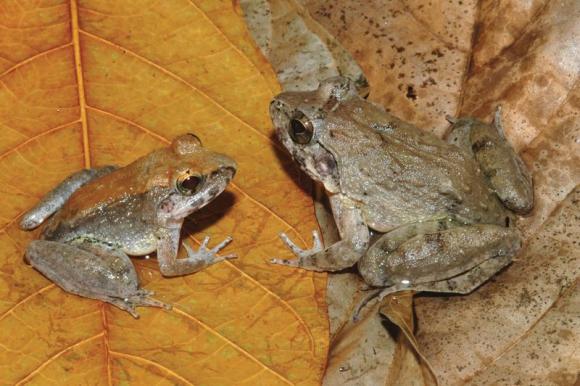
Its fangs are not what makes the newly identified Indonesian frog species Limnonectes larvaepartus unique on Earth. The way it makes babies does.
 |
| The newly described frog L. Larvaepartus, male (L) and female, are pictured from the island of Sulawesi in Indonesia, in this undated handout photo provided by Jim McGuire. |
Its fangs are not what makes the newly identified Indonesian frog species Limnonectes larvaepartus unique on Earth. The way it makes babies does.
This little amphibian from the rain forests of Indonesia's island of Sulawesi is the only one of the world's 6,455 frog species to give direct birth to tadpoles, eschewing the common froggy practice of laying eggs, scientists said on Wednesday.
"Reproduction in most frogs could not be more different from human reproduction. In this case, what is most interesting, ironically, is that the reproductive mode is more similar to our own," said herpetologist Jimmy McGuire of the University of California, Berkeley, whose research appears in the scientific journal PLOS ONE.
This frog, usually gray or brown, measures about 1-1/2 inches long (40 mm), weighs less than two-tenths of an ounce (5 grams) and belongs to the Asian group of fanged frogs. Males possess two fang-like projections from the lower jaw that are used in fighting.
The frog lives along small streams and puddles in rainforest habitats, doing its best to avoid being eaten by larger fanged frog species as well as snakes and frog-munching birds.
Its mode of reproduction sets this frog apart.
"The vast, vast majority of frogs have external fertilization. For mating, the male grips the female around the waist and releases sperm as she releases her eggs," McGuire said.
Those eggs mature through stages including the aquatic tadpole larval phase, typically limbless with a tail that propels it through the water.
About a dozen frog species rely on internal fertilization, McGuire said. All but the newly identified one either deposit fertilized eggs or give birth to froglets, essentially miniature versions of an adult that already passed through a modified tadpole stage while still in an egg capsule inside the female.
The female Limnonectes larvaepartus (meaning "marsh swimmer that gives birth to larvae") instead gives birth to tadpoles.
"It's totally unclear why this mode of reproduction has not evolved more frequently," McGuire said.
"My favorite topic when it comes to frog evolution and diversification is the bewildering variation in reproductive modes that occur. Frogs exhibit all sorts of interesting twists."
There have been frogs that swallowed their eggs and brooded them in the stomach, a species in which the male broods the eggs in his vocal sac, and many species that carry eggs and tadpoles in pouches on their backs and sides, he said.
(Source: Reuters)



